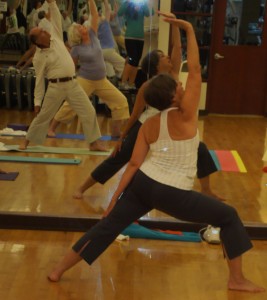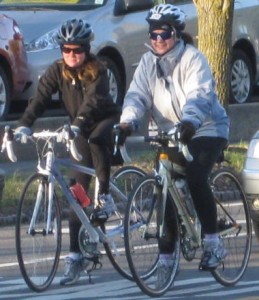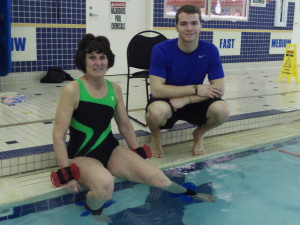by Michelle Sutton-Kerchner
Whether in a deep frost or a milder day, winter signals a common complaint for arthritis sufferers: pain. Soothe away the next few months, until spring’s sun warms your aching bones …
There may not be specific scientific reasons for why the cold exacerbates conditions like arthritis. Research has produced evidence of its truth, with possible links to the cause. Yet, for confirmation, you probably don’t need to search far. Your workout buddy’s bum knee or your own sore shoulder is often confirmation enough of how the cold can, indeed, be bone chilling.
One study followed 200 patients with arthritis, an average of 60 years old. Their pain levels were tracked online while researchers simultaneously captured weather reports near the participants’ locations. The increase in barometric pressure and decrease in ambient temperature was linked to increased pain. Regardless of season, this often occurs prior to weather events. Pain peaks before the storm and plateaus during the event itself.

Indirectly, weather affects the body by putting limitations (perceived or otherwise) on our ability to be physically active. A study following physical activity of 241 adults with arthritis indicated sedentary time increased by over three hours between November and June. Whether a fear of slipping on ice or a shiver at the simple thought of leaving a cozy environment, many don’t want to venture outdoors. Many feel quite lazy, wearing sweats under a blanket on the couch.
A connection exists between cold temps and pain, and right now bones and joints everywhere are begging for a vacation to tropical destinations. Without transplanting your life, make the cold more tolerable to those sore spots.
Pain Predictors
When the approach of a cold snap or increased weather turbulence is forecasted, get proactive. Winter months probably are not ideal for reducing maintenance medications like anti-inflammatory or analgesic treatments. Stay on top of your usual regimen, and perhaps go beyond it, to minimize flare-ups.
Be aware that your usual fitness routine might be effected. Do not push your limits. Investigate other exercise routines before pain renders you unable to function. Remaining in action during conditions that lend themselves to aches helps avoid a full-scale pain crisis.
Keep Your Body Warm
Before a workout, allow plenty of time to warm up. Consider a soak in the Center’s hot tub or time in the steam room before a sweat session. Steady your heart rate with a lukewarm shower, then hit the Exercise Floor. The warmth loosens muscles and joints that are especially stiff and tight from cold weather.
If time is short, warm up by lightly jogging in place or doing jumping jacks. Get your heart pumping and blood flowing to extremities. Never go into a workout cold, especially February-style cold!

Once warmed up, make stretching the first segment of your workout. Although you should not stretch a cold body, once warm, a deep, effective stretching session enhances fitness efforts and helps prevent injuries and stiffness. It also may alleviate discomfort caused by arthritic stiffness.
A personal trainer can help create an effective stretching routine that simultaneously improves flexibility and helps tone. Consider incorporating Pilates and yoga techniques into your fitness program. You may build a pleasant dependence on them that lasts past winter’s woes.
A warm-up isn’t just for your workout’s benefit. Frigid temps affect the way we hold our bodies. A quick burst of activity and a stretch or two before heading into a cold day can help loosen up tensions and ease everything from headaches to sore knees. Holding yourself stiff against a cold breeze or frosty air invites any aches to take a stronger hold.

Remember to dress in layers; wear hats and gloves. A scarf to protect your neck, shoulders, and chest is often recommended by physicians. This area is vulnerable, especially during respiratory infections.
If you’re an avid outdoor exerciser, enjoy a change of scenery. The Center is always alive with inspiration, prompting us to try a new class or build our body better. Once inside, the warmth of the people and the zest of a great workout deliver a powerful remedy against cabin fever. With the climate-controlled environment and extensive options, you can easily transfer your outdoor routine and workout on the coldest days. No frostbite fears!
30 Minutes Daily
Whether officially diagnosed with arthritis or suffering another form of chronic pain, bed rest is a prescription of yesteryears. Experts recommend 30 minutes daily of physical activity in the form of exercise. Particularly at this time of year, 30 minutes may seem overwhelming. Divide them, and include those stretches (which should be frequent throughout the day).
Every day does not need to include a formal fitness routine. Every day should include some fitness movements. Relax– they can be done while at the sink preparing dinner or in front of the TV.
Proper moves help reduce joint pain and stiffness to continuously challenge any range-of-motion limitations and strengthen bones and joints. Keep dumbbells a grab away. A personal trainer also can demonstrate resistance exercises done with the force of your own body.

Focus on low-impact exercises. Yoga, Pilates, T’ai Chi, and cycling are recommended. They strengthen muscles surrounding joints without introducing extra joint stress. Take your workouts to the water. Many Group Fitness classes are offered in the Aquatic center. Some personal trainers are specialized in water workouts. Take advantage of the pool’s soothing buoyancy to lift aches and allow an invigorating fitness experience. During a flare-up, many members head to the pool for relief. It reduces pain while allowing a workout.
Research published in the journal Pain indicates those who exercise, specifically the athletic, tend to better handle hurts. Endorphin release is credited with a pain-blunting effect. Develop, or maintain, an exercise routine to successfully minimize the impact cold has on your body’s aches. Indeed, you may minimize the aches themselves. A frequent exerciser might discover drug-free pain management.
Regular exercise also helps maintain a healthy weight. This is a key element in any arthritis treatment plan. Excess weight puts additional strain on joints, which exacerbates their already compromised condition. An added bonus: Exercise helps improve mood through production of feel-good hormones called endorphins. Along with its effects on the body, winter weather often triggers a blue mood. We need all the endorphins we can get this time of year.
Common Sense Reminders
Avoid carrying heavy bags on your shoulders. Any time of year, this can lead to straining. Hustling around in freezing wind chills while weighed down with bags is like weightlifting with cold muscles. Don’t do it. Try to lighten your load or make more trips. Many use bags on wheels. This helps some areas but negatively impacts the spine by causing poor posture. While transporting your everyday stuff, try to keep your spin properly aligned.

Be sure your daily activities are executed ergonomically. This includes sitting in front of the computer or TV in a supportive chair so the body is lined up correctly with feet flat on the floor. Frequently shift positions and briefly stretch every hour. Lack of movement is largely responsible for arthritic stiffness and pain. Excessive, intense, or extreme movement is also a culprit. Balance activity appropriately, with constant attention to your body’s feedback. Apply warm compresses to sore areas prior to a workout, ice packs post-workout.
Adapt
Sunny, mild days pass quickly. Cold, bitter ones tend to drag. Focus on what you can do. Lift your spirits and alleviate winter’s chill. Radiate warmth through meditative thinking and kind acts. A sunny outlook may not eliminate aches and pains. But, it definitely will improve your reaction to them.
Those sweats were made for exercising, not lazing around all winter. Get moving, get warm, and be comforted.
Sources
“Alternative Therapies for Rheumatoid Arthritis,” by Beth Orenstein at www.everydayhealth.com.
“Knee Pain and Weather: Is There Really a Link?” by Eric Metcalf at www.everydayhealth.com.
www.webmd.com
Image Credits
Iced tree: http://www.flickr.com/photos/brittanyg/3126548946/
Striped socks: www.flickr.com/photos/jvtfotos/3397575091/
Blinding sun: http://www.flickr.com/photos/75356745@N00/3816625781/
 Fitness & Wellness News Your Source for Fitness News, Wellness News, Health News, and Nutrition News!
Fitness & Wellness News Your Source for Fitness News, Wellness News, Health News, and Nutrition News!




